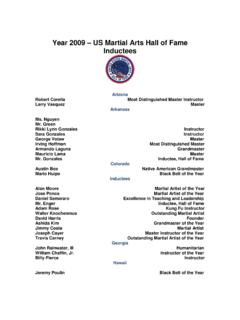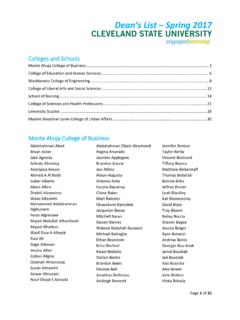Transcription of AN826 Crystal Oscillator Basics and Crystal Selection for ...
1 2002 Microchip Technology 1AN826 INTRODUCTIONO scillators are an important component of radio fre-quency (RF) and digital devices. Today, product designengineers often do not find themselves designing oscil-lators because the Oscillator circuitry is provided on thedevice. However, the circuitry is not complete. Selec-tion of the Crystal and external capacitors have beenleft to the product design engineer. If the incorrect crys-tal and external capacitors are selected, it can lead to aproduct that does not operate properly, fails prema-turely, or will not operate over the intended temperaturerange.
2 For product success it is important that thedesigner understand how an Oscillator operates inorder to select the correct of a Crystal appears deceivingly simple. Takefor example the case of a microcontroller. The first stepis to determine the frequency of operation which is typ-ically one of several standard values that can beselected from a catalog, distributor, or Crystal manufac-turer. The second step is to sample or purchase thecrystal and evaluate it in the product , in radio frequency (RF) circuitry, the selectionof the Crystal is not as simple.
3 For example, if adesigner requires a transmit frequency (ftransmit) of 318 MHz for the rfPIC12C509AG, the Crystal frequency(fxtal) will equal:The frequency MHz is not a standard Crystal fre-quency. Therefore, the designer must order a customcrystal from a Crystal manufacturer. When the designercontacts the Crystal manufacturer, he or she is asked aseries of Crystal specification questions that may beunfamiliar, such as: What Crystal frequency do you require? Which mode of operation? Series or parallel resonant? What frequency tolerance do you desire?
4 What temperature stability is needed? What temperature range will be required? Which enclosure (holder) do you desire? What load capacitance (CL) do you require? What shunt capacitance (C0) do you require? Is pullability required? What motional capacitance (C1) do you require? What Equivalent Series Resistance (ESR) is required? What drive level is required?To the uninitiated, these are overwhelming effect do these specifications have on the opera-tion of the Oscillator ? What do they mean? It becomesapparent to the product design engineer that the onlyway to answer these questions is to understand how anoscillator Application Note will not make you into an oscilla-tor designer.
5 It will only explain the operation of anoscillator in simplified terms in an effort to convey theconcepts that make an Oscillator goal of this Application Note is to assist the productdesign engineer in selecting the correct Crystal and exter-nal capacitors required for the rfPICTM or PICmicro device. In order to do this the designer needs a clearunderstanding of the interrelationship of the various cir-cuits that make up an Oscillator circuit. The productdesign engineer should also consult with the Crystal man-ufacturer about the needs of their product MODELST here are several methods to modeling oscillatorbehavior.
6 One form is known as the one port view ornegative resistance model. It predicts the behavior ofthe Oscillator as an active network generating animpedance equal to a negative real resistance so thatthe equivalent parallel resistance seen by the intrinsic,lossless tuned circuit is infinite [1]. A second form isknown as the two port view or feedback model consist-ing of an amplifier with gain G and a frequency selec-tive filter element with a linear transfer function in thepositive feedback path. This Application Note will usesimplified forms of each view to explain the basic oper-ations of an Oscillator .
7 A more detailed explanation ofoscillator modeling and operation are available in thecited :Steven BibleMicrochip Technology 000 000,,32------------------------------=9 937 500Hz,,= Crystal Oscillator Basics and Crystal Selectionfor rfPICTM and PICmicro DevicesAN826DS00826A-page 2 2002 Microchip Technology BASICSR educed to its simplest components, the Oscillator con-sists of an amplifier and a filter operating in a positivefeedback loop (see Figure 1). The circuit must satisfythe Barkhausen criteria in order to begin oscillation: the loop gain exceeds unity at the resonant fre-quency, and phase shift around the loop is n2 radians (where n is an integer)The amplitude of the signal will grow once oscillationhas started.
8 The amplitude of the signal must be limitedat some point and the loop gain equal unity. It is at thispoint the Oscillator enters steady-state 1:SIMPLIFIED Oscillator BLOCK DIAGRAML ooking at Figure 1, intuitively we see that the amplifierprovides the gain for the first criteria. For the secondcriteria, phase shift, the amplifier is an inverting ampli-fier which causes a radian (180 degree) phase filter block provides an additional radian (180degree) phase shift for a total of 2 radians (360degrees) around the entire design, the filter block inherently provides the phaseshift in addition to providing a coupling network to andfrom the amplifier (see Figure 2).
9 The filter block alsosets the frequency that the Oscillator will operate. Thisis done using a tuned circuit (inductor and capacitor) orcrystal. The coupling network provides light loading soas to not overdrive the tuned circuit [2].FIGURE 2:SIMPLIFIED Oscillator BLOCK DIAGRAM WITH COUPLING NETWORKO scillator OperationOperation of an Oscillator is generally broken up intotwo phases: start-up and steady-state operation. Anoscillator must start by itself with no external the power is first applied, voltage changes in thebias network result in voltage changes in the filter net-work.
10 These voltage changes excite the natural fre-quency of the filter network and signal buildup signal developed in the filter network is small. Pos-itive feedback and excess gain in the amplifier continu-ously increases the signal until the non-linearity of theamplifier limits the loop gain to unity. At this point theoscillator enters steady-state operation. The time frompower on to steady-state operation is the oscillatorstart-up operation of the Oscillator is governed bythe amplifier and the tuned circuit of the filter gain steadies at unity due to the non-linearity ofthe amplifier.













